This article will provide you with a complete list of the best fighting knives in the world. Some of these combat knives have a long record and have even been used by regular military personnel and special combat units in many missions and wars. Either way, along with the everyday home utility, military, or campsite cutting duties, a knife works an integral part in self-defense just after a firearm.
Best Combat Knife – Top List
- Gerber StrongArm Fine Edge Military Knife
- Ka-Bar KA1214-BRK USA Fixed Blade Fighting Knife
- SOG SEAL Pup M37N-CP Fixed Blade Combat Knife
- Schrade Delta Class Needle Fixed Blade Military Knife
- Cold Steel Leatherneck-SF Combat Knife
- Ka-Bar KA1245-BRK Black Tanto Combat Knife
- Ontario SP-1 American-Made Affordable Combat Knife
- Smith & Wesson CKSUR1 Search & Rescue Fighting Knife
- Smith & Wesson SW3B Bayonet Military Knife
- SOG Tech Bowie S10B-K Fixed Blade Combat Knife
- KA-BAR Kukri Machete Large Fighting Knife
Best Combat Knife
1. Gerber StrongArm Fine Edge Fixed Blade – Top Combat Knife
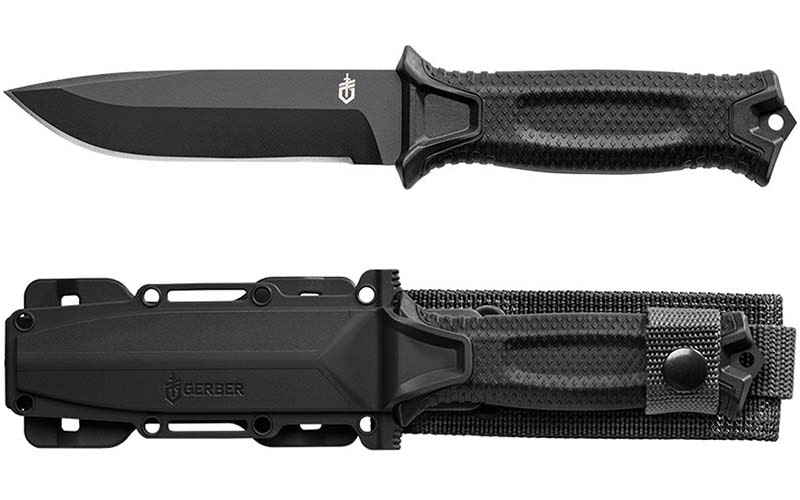
Gerber StrongArm is a full-tang combat knife that stays true to the roots of traditional military-style survival knives. With a lifetime warranty, the 9.8″ long StrongArm is proudly manufactured in the USA at Gerber’s Portland, Oregon factory.
The knife has a 0.19″ thick drop point blade made of 420 high carbon stainless steel (58-60 HRC) and protected with a black ceramic coating. The steel core contains additional amounts of chromium which enhances the toughness, corrosion resistance, and long-lasting sharpness of the blade.
Its 4.8″ long fine edge blade is capable of cutting hard to flexible materials such as ropes, set belts, branches, electrical wires, as well as batoning or chopping the firewood. Due to the high carbon steel, the blade quickly and easily takes a razor-sharp edge.
Its 5″ long ergonomic handle is crafted from Glass-Filled Nylon. The diamond-texture rubberized handle gives a comfortable and anti-slip grip that fits snugly in the user’s hand.
Also, the handle base has a small striking pommel that can be used to break through hard surfaces in emergencies or during rescue operations. There is also a lanyard hole in the pommel.
With the Gerber StrongArm, you can choose to carry your knife in many ways. From drop-leg system to MOLLE mount to horizontal belt mount – this 7.9oz weighing knife comes with a multi-mount sheath. The sheath allows both active and passive retention – relying upon the mount you use.
Check out its partially serrated version: Gerber StrongArm Serrated Edge Fixed Blade Knife
Pros
- Full tang design for good balance and solid construction
- Rust-free 420HC steel blade which can be sharpened easily
- The blade is strong enough and suitable for all kinds of hard work
- Remarkable edge holding capacity, no hassle for sharpening again and again
- Ergonomic handle for a comfortable grip and easy handling
- The handle is strong, stable, well-sized, waterproof, and unaffected by chemicals or weather
- The multifunctional sheath allows versatile and secure carrying options
- An American-made knife is absolutely worth every penny
Cons
- Some users are not happy with the pointed pommel
- Really nice knife, I couldn’t find any more cons
2. Ka-Bar KA1214-BRK USA Fixed Blade Fighting Knife
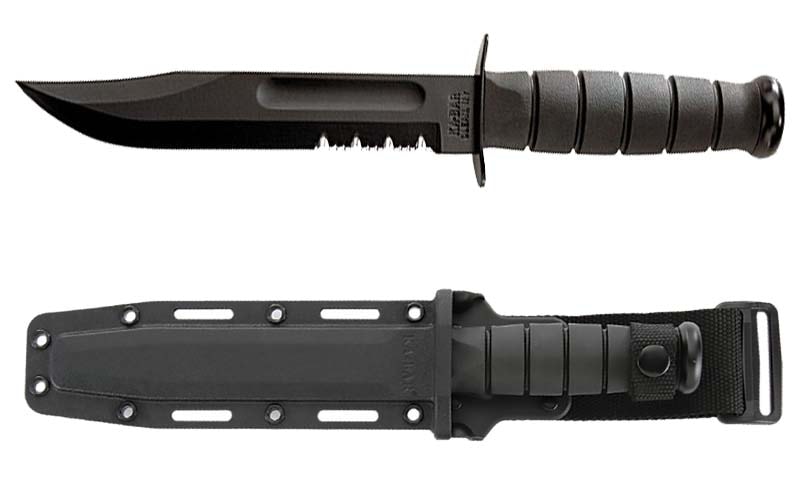
If you require the same features that the US Marine demands in their combat knife then you don’t need to search further, the “KA1214-BRK” is the one. The 11.88″ clip point knife gives the surety of a complete kill if the knife is used in any fighting or against a wild animal.
Its 7″ long blade is made out of 1095 Cro-Van stainless steel. With 56-58 Rockwell scale and full tang structure both have made the blade strong and nearly indestructible. The 4.19mm/0.165″ thick razor-sharp blade has a 20-degree partially serrated cutting edge.
The blade is finished with a non-reflective black powder coating to protect it from rust and corrosion. It also increases scratch resistance and decreases friction drag as well.
The best part is, KA1214-BRK comes with a weatherproof Kraton G (that is a composite material of Synthetic Elastomer) handle. The handle feels comfortable and fits perfectly in my hand.
This type of grooved handle provides much better grip and control in tropical, snow, or wet conditions. Even in any extreme situation, you can use the pommel as a hammer and it will not crack or break like wood.
The hard plastic-made sheath has the option to carry it on both left and right sides. The sheath is well matched to tropical circumstances because it repels moisture and water quite well.
Moreover, the sheath comes with another safety system for the kids; when the knife stays in the sheath, a snap strap wraps around the knife handle.
This sturdy knife is a multi-use tool whether for fighting, self-defense, utility, or in any camping, survival, hunting trip, or any other outdoor chores.
The same model is also available in the plain edge version: Ka-Bar #1213 Black Straight Edge Knife
Pros
- The knife arrived scalpel-sharp out of the box
- Easy to sharpen with any sharpening stone/ceramic/diamond
- Blade holds a sharp edge despite a lot of abuse
- Got less snagging for rounded serrated edges
- Kraton G is tougher than wood and lasts longer than leather
- The cross-guard secures your fingers during fighting
- Durable hard plastic sheath for secure carrying
- Maintaining or cleaning is quite easy
- Ka-Bar KA1214-BRK is proudly made in the USA
- It has a limited lifetime warranty
Cons
- I like everything except sharpening the serrated edge
3. SOG SEAL Pup M37N-CP Fixed Blade Comat Knife
If you want a knife that is compact, easy to carry, and use as well as cheap in price then SOG SEAL Pup M37N-CP will be your best choice. The knife is not too big or heavy; it’s also not too small for tactical use. Its overall length is 9″ and its weight is 5.4 oz.
The manufacturer uses their famous powder-coated stainless steel AUS-8 (HRC: 57-58) to make this knife’s 4.7″ blade. The alloy goes through an innovative cryogenic heat treatment process that dramatically increases the blade’s hardness, sharpness, and edge-holding ability.
The backbone of the partially serrated blade is pretty thick 4.83mm and quite strong but the thickness gradually tapered towards the tip.
The serrated part of the blade makes it easy to cut the rope, paracord, set belts, and electric wires because teeth really grip flexible material well and the plane sharp part slices cleanly through other materials.
Also after using the knife for clearing small branches, feathering or chopping sticks, and processing firewood, the blade retains its edge well and only noticed some scratches on the finish.
It is a full-tang knife with a glass-reinforced nylon handle molded around it. The ergonomics are excellent and very nicely balanced and this handle feels very secure to hold.
The handle has guards, finger grooves, and many raised diamond patterns to resist slip. This knife never slipped out of my hands even if my hand or the handle got wet while using it for various tasks.
The knife can be carried easily with the versatile nylon sheath. The sheath has a vertical strap that allows me to conveniently attach the knife to a belt, pack, gear, or “MOLLE”. The sheath also has a pouch that will hold a pocket sharpener or Ferro rod.
If you don’t like a nylon sheath or need a Kydex then click here to purchase this SOG SEAL Pup M37N-CP with Kydex sheath
Pros
- Cryogenically heat-treating steel at the atomic level
- The knife came quite sharp out of the box
- In a short time, it took a razor edge with little effort
- The handle is not slippery and feels solid in my hand
- Water, electricity, and weather-resistant handle requires zero maintenance
- The molle-compatible nylon sheath is more functional
- Don’t worry the knife has a lifetime conditional warranty
- It is one of the best pure fighting knives under $100
Cons
- The handle is a little short for my larger hand
- I think the sheath could have been of better quality
4. Schrade Delta Class Needle Fixed Blade Military Knife
The Schrade Delta Class Needle is the best military knife for those looking for a personal defense knife that is large in size but light and easy to carry. The 12.25″ long Schrade SCHF44LS is a lightweight fixed blade knife designed primarily for combat, tactical, and self-defense use.
Be aware that Amazon and other places have some misinformation about this knife that you shouldn’t be confused by. You can rest assured that all the information I provide here about the features of this knife is 100% authentic.
The 7.5″ long double-edge blade is crafted from 7Cr17MoV high carbon stainless steel with 40% serrated and 60% fine edge. The blade feels a tiny bit flimsy (2.29 mm thick) but surprisingly enough strong. It is full tang and has a powder coat finish for protection.
The spear point blade came crazy sharp right out of the packet. In my experience, the design and weight of the knife make it more suitable for various combat techniques such as stabbing, piercing, quick maneuvering, and throwing in a target than other knives. Besides, with combo edge, I have been able to easily cut almost all types of hard, soft, or flexible materials in sawing or pushing motion.
The classic design handle is made of textured thermoplastic elastomers with a lanyard hole at the end. The handle is very ergonomic for holding in any position as well as forward or reverse gripping. In addition, the front quillon ensures maximum safety of the user’s fingers when stabbing or maneuvering the knife quickly.
However, I found the handle a little small for my large hands, so I added a paracord to the lanyard and wrapped it around my wrist to easily perform various combat moves very safely.
The knife comes with a slim and low profile original leather-made black sheath. For concealed carry, there is a steel clip that can be attached to the back (on your belt) or on a boot.
Note that this is not a knife suitable for heavy use or for survival, bushcraft, camping, or hunting trips. So never abuse it unless there is a special need.
If you want a stronger knife than this, check out the Gerber Mark II.
Pros
- A lightweight knife (7.68 oz) is perfectly designed for hand-to-hand combat
- Very fast and easily can be maneuvered
- A bit big but can be used as a boot knife
- A light and thin knife can be easily concealed and carried
- Decent quality leather sheath, no friction, and thumb break fastener
- Schrade offers a limited lifetime warranty for this knife
- A well-designed fighting knife at a very low price
Cons
- Not for chopping, batoning, notch, or abusing
- The blade and handle are a little thin
5. Cold Steel Leatherneck-SF 39LSFC – Best Combat Knife Under $100
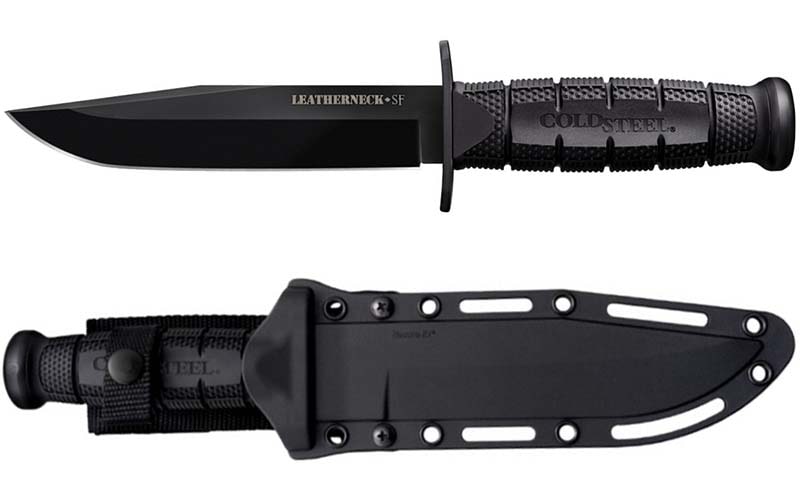
The Cold Steel Leatherneck is a multi-purpose survival combat knife that reminisces the 1776 U.S. Marines. Its 6.75″ clip point blade is made out of famous German tool steel D2 (HRC: 59-62). The hollow grind blade came absolutely shaving sharp right out of the box.
The D2 has higher edge retention because after more than three months of doing almost all kinds of heavy work with the knife (stabbing into dense objects, firewood batoning, and feathering or chopping sticks) its sharpness decreases slightly. The knife needed sharpening for the first time after about four and a half months of use.
The blade is protected with a non-reflective black powder coating. In addition, after washing with the water and despite not giving any kind of oil coating, no crutch or rust was detected within five months.
The 0.19″ thick plain edge blade of this knife is full tang – perfect for fighting, survival, camping, hunting, or tactical use.
This knife has my favorite handle which gave me a non-slip grip in wet, sweaty, or muddy conditions. The choice of textured Kray-Ex for the material of the handle is impeccable for a high-performance grip.
The handle rightly hugs my palm through the oval cross-section and exclusive finger troughs. The full tang handle has a solid steel butt cap so I felt free to use it as a hammer to break something hard.
The balance point of this knife is just right in the middle, so I didn’t feel any fatigue or blisters on my hands after using it for long periods of time.
Speaking of safety, a solid steel double quillon guard is integrated with the knife to prevent the user’s fingers from sliding towards the sharp edge of the knife and also provide essential protection in hand-to-hand knife combat.
The 11.7 oz weighing knife also comes with a distinct Secure-Ex sheath – in order to make carrying it around safely. The sheath can be completely detached and features a belt loop that is ambidextrous.
This 11.75″ combat knife is made in Taiwan and comes with a manufacturer’s limited lifetime warranty
Pros
- A fully straight edge blade is easy to sharpen
- Super strength, edge holding, and corrosion resistant
- The 5″ handle is very ergonomic and comfortable in difficult conditions
- Solid steel guard for fingers protection and machined end-cap for striking
- The sheath securely holds the knife and is easy to mount on the MOLLE
- Its robust construction will give you the confidence to take heavy abuse
- For this price point, this knife is hard to beat
Cons
- The hollow grind blade has a thin weak tip
- It took me a little longer to re-sharpen because the hardness is higher
- It would have been better if the weight of the handle was a little less
6. Ka-Bar KA1245-BRK Black Tanto Fixed Blade Combat Knife
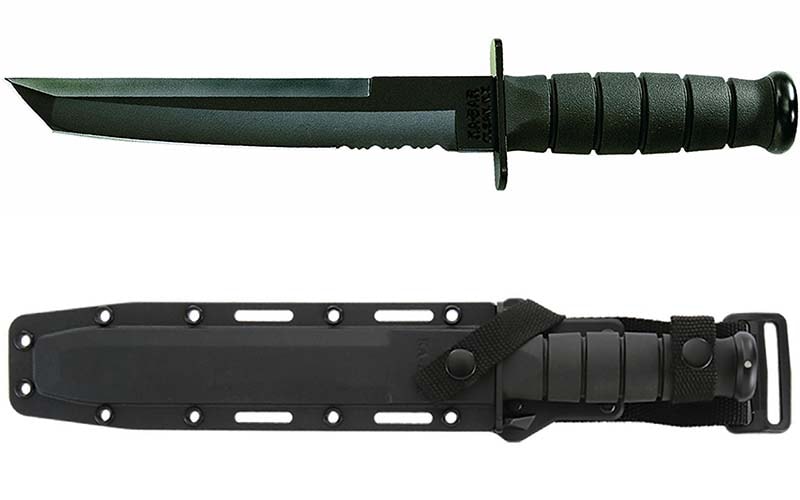
The Ka-Bar KA1245-BRK has an 8″ long and 0.165″ (4.19mm) thick tanto point blade. Its weight is 11.2 oz (0.70 lbs) with an overall length of 12.81″. The partially serrated blade has a black epoxy powder coating for wear and corrosion resistance.
The core component of the blade is made of premium quality 1095 Cro-Van stainless steel. This type of carbon steel is produced with a combination of Vanadium (0.42-0.55) and Chromium (13.8-15) intertwined with the 1095 steel. The Vanadium component of the steel provides razor sharpness with the highest edge retention, and Chromium increases strength (56-58).
The serrated part of the blade is not too aggressive, and the strong tanto tip is able to penetrate thin iron or wood objects or thick cloth very easily. I have used the knife for various purposes such as – chopping small branches, and logs; making feather sticks and limbing trees; cutting rope, paracord, fences, electrical wire, and other fundamental tasks.
Since this is a traditional fighting knife, the blade’s spine is not flat but narrow, so only small wood, logs, and branches can be batoned with the knife, but heavy batting should not be done.
After about three and a half months of using the knife, I needed to re-sharpen it.
The full tang knife has a manmade Kraton G handle. On the handle profile, I found deeply rounded finger troughs that ensure solid gripping even when wet and don’t slip at all.
The handle is complemented with a thick steel butt cap (the cap is not plastic or cheap molding like other products on the marketplace nowadays). So I didn’t hesitate to use the butt like a hammer anywhere to inflict terrible blows.
Moreover, this combat fixed blade knife has a steel cross guard. This is an important feature of any combat knife as the guard will protect your fingers when applying it for stabbing/puncturing or reverse gripping in close combat situations.
For safe carrying and transport, Ka-Bar has provided a hard glass-filled nylon black sheath with this fixed blade fighting knife.
Pros
- The blade came fairly decent sharp right out of the box
- The blade is tough and holds its edge very well
- Easy to sharpen, takes a keen edge in minutes
- The handle can withstand freshwater, marine, snow, and mud
- The handle fits my large hand perfectly
- Not too heavy not too light, balanced feel, and very durable
- Finger protective guard and steel butt cap
- The knife comes with a sturdy and MOLLE-compatible sheath
- The Ka-Bar KA1245-BRK is proudly made in the USA
- Don’t worry; the knife has a limited lifetime warranty
- Build quality and features are very good at a great price
Cons
- Required a bit of sharpening to make it hair-popping sharp
- Being carbon steel you will store the blade lightly oiled to avert corrosion
7. Ontario Sp-1 American-Made Combat Knife
The Ontario wanted to bring the best military knife that can accommodate nearly any combat requirements that you might have. This extensive approach is visibly noticed by the sheer glut of unique and multifunctional features of the SP-1.
The Ontario SP-1 is an American made most affordable fighting knife that is specifically designed for first responders, sportsmen, and special combat units.
The 6.88″ blade of this knife is made of 1075 carbon steel (HRC 57-59) and coated with a black epoxy powder – which gives it a stealthy finish. The 1075 alloy is known for better edge retention and quick sharpening. The blade is very thick 0.19″ and full-tang. Also, it has a plain edge and sturdy clip-point tip.
The blade I found out of the box was sharp enough but not a hair-popper. Although it only took five minutes to sharpen like a razor with my Wicked Edge Gen 3 Pro knife sharpening system. The tip is very thick and precise so it can easily penetrate objects like steel or tin cans, woods as well as being brutally tested as a lever.
With the blade, I was able to easily chop tree trunks, baton and split woods 3-6 inches thick, accurately hit targets 10 feet away by throwing the knife, and cut down electric cable or half-inch thick paracord.
The spine is very thick and completely flat so igniting the Ferro rod is quite easy. Even I have split logs and bricks into pieces using the spine as a hammer.
After all these abuses, I thought the tip of the blade might bend or break and the sharp edge might get some big chips or cracks. Surprisingly nothing happened except for a few microchips and some loss of sharpness.
Moving on to the knife’s handle, it is manufactured from molded Kraton. The 5.125″ handle has ergonomic finger grooves, a nice weight, and balance too. With a rounded structure, the handle is designed to fit a large hand perfectly with a high-performance grip. The rubberized handle feels very grippy, comfortable, and solid in my hand.
The handle is equipped with a double-finger guard to ensure the safety of the user’s hand. Also, the pommel has a lanyard hole.
To safely carry this 12″ fierce-looking knife, it comes with a MOLLE-compatible heavy-duty nylon belt sheath. With plenty of mounting options to choose from, the nylon sheath provides really good retention and protection.
This 9.9 oz weighing combat knife is proudly made in the USA and offers a lifetime warranty.
Pros
- A good quality American-made combat knife for forty dollars – really surprising
- Carbon steel blade quickly and easily takes a razor-sharp edge
- Holds an edge well – once sharpened, doesn’t blunt very quickly
- The troughs and guards ensure a non-slip grip and secure use
- MOLLE compatible tactical sheath with a hard plastic insert
- The solid construction of the knife gives confidence in heavy-duty use
Cons
- There is no metal cap on the pommel
- Better stored with oil and can rust if not taken care of properly
8. Smith & Wesson CKSUR1 Search & Rescue Military Knife
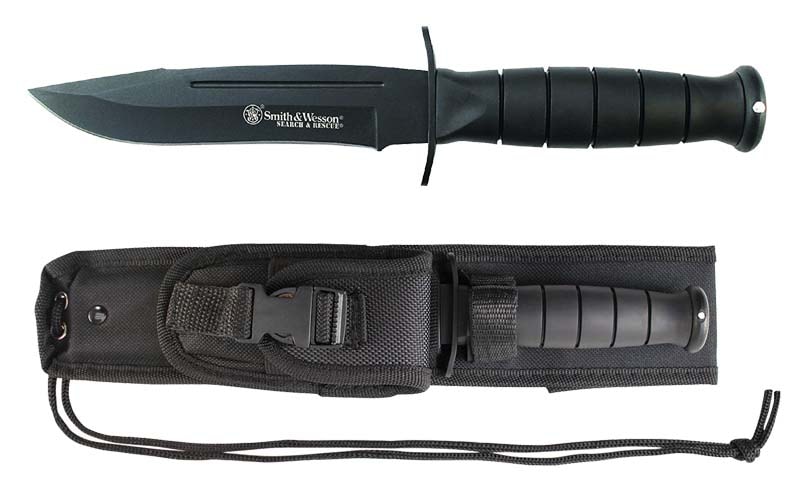
The CKSUR1 offers incredible value for your money and has been specifically designed to meet all your combat needs. Smith & Wesson combines craftsmanship, strength, and bowie style into this good fighting knife. The knife features a 6.03-inch modified clip point blade of Black 7Cr17 High Carbon Stainless Steel. The 4.76 mm thick stainless steel blades are virtually indestructible, meaning this blade can take a beating and last a long time without rusting.
However, the Smith & Wesson CKSUR1 is not serrated, so the knife will work better for chopping wood, and is easier to sharpen. If you’re without a whetstone, you can even use an excellent smooth stone for sharpening, making it a razor-sharp combat survival knife. The blade features a black powder finish, which not only supplements the aesthetics but also serves the purpose of minimizing corrosion and reflection. The CKSUR1 offers a limited lifetime manufacturer’s warranty.
Apart from the pragmatic and durable blade, another feature that made our team include this knife in our top ten best combat knives list is the rubberized aluminum handle that makes the 10.5 inches knife extraordinarily comfortable and less slippery in your hands. For convenient and secure transportation, the knife also comes along with a heavy-duty multipurpose nylon sheath that is manufactured with metal reinforcements and a hard synthetic liner. The sheath is decorated with a sharpening stone, lashing slots, a D ring, and a front-mounted nylon-made removable storage pouch together with a Velcro shutter. Weighing just a mere 7.0 ounces means the knife is lightweight and easy to carry.
9. Smith & Wesson SW3B Special Ops Bayonet Combat Knife
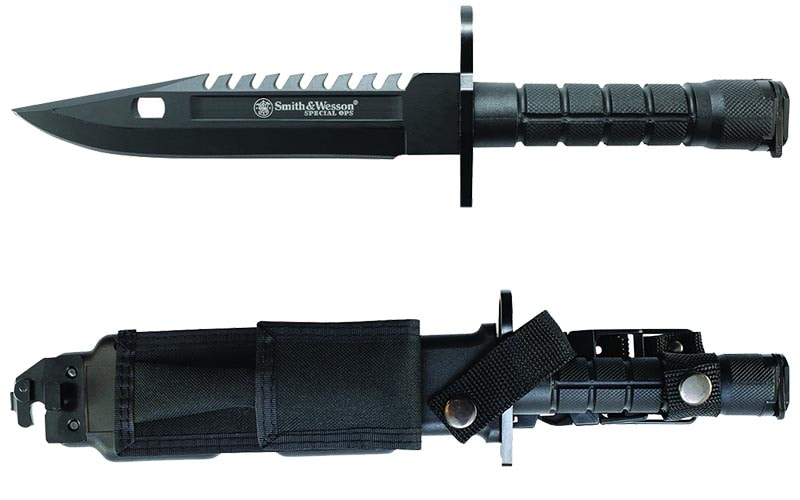
Smith & Wesson SW3B Special Ops Bayonet is one of the top combat knives for survivalists, special forces, and outdoor enthusiasts. The United States military highly trusts this fighting knife for the M16 rifle’s bayonet. The full length of the knife is 12.8″ and weighs 14.5 oz.
The 7.8″ blade of this knife is made of high-quality 420J2 stainless steel (HRC 58-59). The 420J2 steel is known for its superior strength and corrosion resistance due to its high chromium content. It is coated with black oxide powder that makes it more durable along with stain and rust-resistant.
Additionally, the blade has a modified spear point tip that is slightly thicker, yet sharp enough to easily penetrate very thick objects. Also, the blade spine is notched which gave me more advantages than sharp edges for cutting thick tree limbs as well as wood or hard things.
The good news is that the blade steel and its hollow grind edge are so strong that even after three months of heavy abuse I didn’t need to sharpen the knife very often.
The handle is made of textured Nylon with black rubber inlay. Rubberized texture, grip pattern, and rounded finger troughs – all these features indicate that the knife has an ergonomic handle for a confident grip. The knife never slipped even when my hands were muddy or wet during normal and heavy-duty use.
To carry this huge knife the company has provided a versatile sheath or scabbard which I liked the most. The scabbard is complemented with hard plastic and nylon.
It has a 45-degree belt loop, a small extra adaptor, a removable pouch, and a built-in sharpening stone. I can easily separate and attach those altogether.
Furthermore, the blade hole joins with a scabbard lock and makes a wire cutter. Also, the head of the tool can be used as an emergency screwdriver.
Pros
- The knife is large, thick, and built just as solid
- The knife came shaving sharp out of the box.
- Although the blade is stainless steel, it was easy to sharpen
- There is a spacious blood groove on the body of the blade
- A notched spine can do many things that are not possible with a sharp edge
- The handle is well-sized, comfortable, and feels very sturdy in my hand
- Its large guard protects my fingers from the keen edge
- The multifunctional tactical scabbard holds it firmly
- The military knife offers a limited lifetime warranty
Cons
- This is a half-tang combat knife
- The cheap black coating wears off easily after extreme use
10. SOG Tech Bowie S10B-K Fixed Blade Fighting Knife
If you want a classic bowie knife, but its features and design that is focused on modern warfare techniques, then the SOG Tech Bowie is the perfect knife for you.
The 6.4″ long bowie blade is made of premium quality AUS-8 steel with a durable black TiNi finish. In addition, SOG’s renowned cryogenic heat treatment process not only increases the strength of the steel core but also greatly increases edge retention and wear resistance.
The hollow-ground blade came out of the box hair-popping sharp; grinds and other edges were smoother. The full tang blade is 6.096 mm thick but gradually tapers towards the tip, overall it’s a very sturdy blade capable of doing whatever you ask it to do.
I have used this knife on my camping trips for a variety of tasks ranging from de-limbing, carving, cutting sticks, and splitting small logs for campfires, processing meats, fruits, pumpkins, and vegetables, and hammering tent stakes.
After about two and a half months of heavy use, I noticed a slight dulling of the knife which I was able to easily re-sharpen the blade in a few minutes with a whetstone.
The glass-reinforced nylon handle feels very comfortable and fits perfectly into my large hand. The handle gives a slightly sticky rubberized feel when held. The ergonomic handle has plenty of grip patterns along with finger grooves to make it non-slip under any conditions.
The high-end fixed blade knife comes with a Kydex sheath with a snap closure and belt loop attachment. The sheath is smooth and very form-fitting. Also, the sheath will not be damaged by water, and having a drainage hole, water will not accumulate in it.
It offers enough flexibility as the knife can be easily sheathed and unsheathed. Also without using the retention strap, the sheath is able to hold the knife firmly in a sideways or upside-down position, although I would always recommend using the strap.
If the SOG Tech Bowie is unavailable you can check out two other knives of the same design but better quality (1) SOG Super Bowie – SB1T-L and (2) SOG Bowie 2.0 – S1T-L
Pros
- Heat-treated AUS-8 stainless steel does not rust easily
- The blade is easier to sharpen but doesn’t dull too quickly
- The cross-guard and slip-less solid grip provides a strong sense of confidence
- The ergonomically contoured handle is easy to hold and very well balanced
- The sheath is durable, hassle-free in and out, and snap closes easily
- An all-purpose bowie knife is a bit pricey but definitely worth the money
- Limited Lifetime Warranty covers any defects in manufacturing and materials
Cons
- Hollow-ground blade is not suitable for heavy batoning
- The sheath is very thin and poorly designed
- The belt buckle loop is bulky and flimsy
11. KA-BAR 2-1249-9 Kukri Machete Fighting Knife
Currently, in some countries or regions of the world, larger knives, especially kukri and machete are more popular than smaller tactical knives for knife fighting among various groups of clans or armies. If you are looking for such a knife then I recommend you the “KA-BAR 2-1249-9” model which is a combination of kukri and machete.
Although this knife is quite large (17″), it is well-balanced so it can be maneuvered very easily. I think it would give a lot more advantage than a small or medium-sized knife in any fight. However, its large size makes it difficult to conceal or carry regularly.
But if you want an ideal hard-use chopper for farm and home yard cleaning, or for survival or camping trips, then you wouldn’t find a much better knife at this price.
The 11.5″ long curved edge blade is made by Ka-Bar from their famous high carbon steel 1085 (HRC: 52-54). The full tang blade is 0.16″ thick and powder-coated for protection. The grind of the plain edge blade is hollow and its edge angle is 22 degrees. The pretty thick blade came perfectly sharpened from the factory.
The blade is slightly heavier towards the tip which gives the user leverage for heavy chopping. I cut through most branches, small trees, pumpkins, watermelons, twigs, canes, or palmetto bushes in one swing.
I did a lot of light work with the knife in the first month and believe me its edge retention is so good that I didn’t notice any difference in sharpness. But in the second month, I started heavy use. I have chopped 5-7 inches thick trees in 60-70 swings as well as batoned 3-6 inches thick firewood for my cabin.
By the end of the second month with heavy use, I noticed some chips and the sharpness decreased a lot. As the blade is high carbon steel, these defects are easily recovered with a few minutes of sharpening.
The spear point-shaped tip is strong enough to stab and pierce through wood or similarly dense material.
The handle is made of Kraton G thermoplastic elastomer. The handle is large enough (5.50″) and fits like a glove on my large hands. The handle has an ergonomically curved shape, 5 rounded grip troughs, and a hook on the back, which prevents my hands from slipping off suddenly in wet or sweaty conditions.
Apart from this, the handle material is soft and rubberized, so it not only acts as a shock absorber but also never caused any blisters or fatigue in my hands even after chopping lots of wood for a long time.
Along with the knife, I got a standard sheath made of a leather/Cordura combination. The sheath has a belt loop and two retaining straps with two button closures attached. There is also a D ring for lashing. The sheath is able to hold the knife very well, even hanging it upside down.
Pros
- The blade edge is very sharp out of the box
- The blade is flexible, durable, and won’t bend under heavy use
- Really fast took a keen edge and held its edge well
- The handle is ergonomically large, anti-vibration, and very slip resistant
- The full tang handle feels solid, balanced, and secure
- The knife is hefty and powerful but not too heavy (1.7 pounds) while walking
- The knife is made in Taiwan, not China
- The knife is fully backed by KA-BAR’s limited lifetime warranty
- For the price, I think anyone would be hard-pressed to find a better knife
Cons
- The sheath could be better, however, it’s ok with the price in mind
How to Choose the Best Fighting Knife
Knives have been an important tool for humans throughout our entire history. Not only can they be used in many different tasks, but act as an efficient weapon in combat. Different types of combat knives have been used in situations ranging from war to self-defense.
However, with so many varieties, it can be difficult to find the right combat knife. For this reason, here I will try my best to explain to you what to consider when buying a fighting knife.
Fixed or Folding – Which One Is Best for Combat Knife?
One of the larger debates when choosing a combat knife is whether it is a fixed blade knife or a folding knife.
The latter means that the blade can fold into itself, making it easier to carry and not requiring a sheath. This allows the user to keep the presence of the knife a secret from an attacker, making it a surprise advantage if combat ensues.
However, the folding point of the knife is its weakest, and once it is damaged, the knife ceases to fold out easily and making it worthless.
Additional weaknesses include the time it takes to unfold the knife, during which the attacker is either getting closer or attacking; there is a chance for the knife to fold in on itself unexpectedly, even cutting the user.
My recommendation is pocket knives for fighting are preferable for police, or paramilitary forces.
So, choosing folding knives would not be a good idea for using them as personal self-defense for citizens or military forces. A fixed blade knife is not prone to broken folding mechanisms, is easy to use or carry, and overall is more solid.
But a fixed blade knife for combat also has some cons. A fixed blade is unable to become concealed, and there are lots of restrictions to carrying it in a public place.
Lastly, keeping the blade hidden away may not be the goal of the user, as its presence may cause potential attackers to avoid, flee, or surrender to the user.
Consider the Measurement of A Combat Knife
There is a lot of controversy about the size of the combat knife. If a knife is too short, it makes it weak, less likely to penetrate, and gives it a shorter range; too big of a knife and it becomes unwieldy.
Different sizes of knives are required in different cases. So that you can understand the matter better, I will try to explain the measurement of a fighting knife in three different parts.
• Small Combat Knife: The blades of knives of this size are 2-5 inches in length and 5-10 inches in total length.
The most popular combat knives of this size today are Tactical Folding Knife, Boot Knife, Neck Knife, and Stiletto Knife.
This small size allows them to be easily hidden and carried. However, this limits its strength and usefulness.
• Medium Combat Knife: The blade lengths of fighting knives in this range are within 5-8 inches and 9-14 inches overall. Nowadays worldwide, most users of this type of knife prefer this average common ground.
There are many good and effective fighting knives of this size, such as Tactical Knife, U.S. Military Bayonet Knife, USMC Fighting Knife, Dagger Knife, Karambit Knife, Trench Knife, and Ballistic Knife.
It gives it a weight and length that is effective, yet won’t weigh the user down. This balance between large and small gives it the power small would have and ease of use large may limit.
• Large Combat Knife: A large fighting knife would be 12-18 inches in total length, with the blade being 8-12 inches long.
Machete Knife, Bowie Knife, Kukri Knife, and Dirk Knife are my favorite knives of this size.
This knife has the most range and power potential. However, its larger size might be unwieldy in inexperienced hands.
Choosing the Blade Steel of Military Knife
Blade steel is extremely important when deciding which knife to choose. This is because this will be the deciding factor of many attributes of the blade, including resistance to corrosion, ability to flex, ease of sharpening, hardness, retention of edge, and many more.
Although weight may seem important, it is less so when it comes to the best military knives due to their smaller size. Unfortunately, no material can be high performing in all the attributes listed below, as many require a tradeoff with another.
The main choices for blade material when talking about knife-making steels are…
• Tool Steel: Knife-making tool steel usually has a carbon content between 0.5% and 1.5%. It is best for keeping its edge, but it takes an extremely long time to sharpen and has average corrosion resistance. The best tool steels for making knives are A2, D2, O1, M4, and CPM series.
• Stainless Steel: Stainless steel for knife making has less than 1% carbon content and more than 10% chromium content. This alloy is extremely effective at resisting corrosion such as rust and is comparatively easy to sharpen, but in hard use, its edge doesn’t last long. The most commonly used knife-making stainless steels are S30V, S35V, S45V, CTS, 400, AUS-8, AUS-10, MoV, 154CM, 420J2, Sandvik, and VG.
• Carbon Steel: All those knife-making steels which contain 1%-2% carbon and chromium content of around 10.5% are called high carbon stainless steel. The steel is very durable, relatively easy to sharpen, and takes a sharp edge, yet is prone to corrosion. Some of the most famous and widely used knife-making carbon steels are 420, and 1095.
Due to the primary purpose of the knife in question, combat, the main attributes that will be important are being able to get a good edge and the knife being tough.
This means that carbon steel would be the best choice when you need to select durable combat knives. Although it may be affected by corrosion, this can be prevented through proper care.
Selecting the Blade Shape or Tip of Fighting Knife
Seeing as this is a combat knife, the blade shape and point are extremely important. These will affect what attacks the user can do and the effectiveness of different attacks.
• Drop Point: A drop point is a blade in which a non-sharpened convex curve goes from the back of the blade to the point. Benefits include a strong tip and long cutting edge, making it great for slicing. However, it does make the point broad, making it a poor-piercing weapon.
• Clip Point: It has an unsharpened back that is straight to about halfway up the blade and then goes toward the tip, which can be curved or straight. This allows it to perform well at both slicing and piercing. However, due to its narrowness, the point is weaker.
• Spear Point: A spear point is a blade that is symmetrical along the long axis. It can be single or double-edged; the latter is suggested to allow a sharp point. Due to its design, it has a strong and potentially sharp point, making it good at piercing, but with limited slicing power.
• Scandi Point: A scandi point has a start straight on both sides with both edges curving towards the point. It is easy to keep sharp, but it is time-consuming due to the amount of material. Since the cutting edge tapers thin, it isn’t good in regards to slicing and strength.
• Hollow Point: A hollow point is a blade in which both sides have a conclave edge ground into them, coming together for a thin point. This thin point is very light, making it good for slicing. Its sharp point can pierce well, but its thin nature is prone to breaking.
• Full Convex: A full convex has a gentle curve starting at the base of the blade guard. Due to its shape, it is extremely durable and keeps its edge. Unfortunately, this means it takes a while to get the edge when it is needed.
The Blade Spine of Military Knife
The blade spine is the side opposite to the cutting edge. Although this is often flat, it can be used to increase a knife’s potential.
If the knife is made to be double-edged, the point becomes sharper, as well as providing another sharp edge to attack with. However, some disadvantages are that the knife will be lighter, which limits its power.
Some have large serrations on the spine that can be used to cut extremely hard and thick objects.
Selecting the Blade Edge
The blade edge is one of the primary ways a blade is used in knife fighting, the other being the point, making it very important. It should always be kept sharp, as a dull knife is less effective and acts as a danger to the user.
An important decision to make a choice whether a combat knife blade edge is plain or serrated.
• Plain Edge: A plain edge is the usual type of sharp edge when people think of knives. Their simple shape makes it easy to sharpen. Additionally, they tend to be sharper and more precise.
However, it requires more sharpening and can have difficulty cutting through tough or flexible material. They work best with push cuts, rather than slicing.
• Serrated or Saw-toothed Edge: A serrated edge was created to do effectively what a straight edge could not, that being cutting through tough material.
The teeth that make up the edge are great at cutting through things such as thick clothing, even when teeth are dull. The saw-like edge can also cause greater damage in combat by catching the attacker’s skin or clothes.
However, it comes with its own weaknesses, such as potentially getting stuck and difficulty in sharpening a serrated knife.
• Combo or Partially Serrated Edge: In recent years, many knives have had a combination of a sharp and serrated edge on one side or putting them on opposing edges. This allows the user to reap the benefits of both types.
However, it isn’t perfect. The knife also has weaknesses associated with both, and where each component is placed greatly controls how effective each part is.
Consider the Knife Tang
The tang of a fixed blade knife is a piece of metal that goes from the base to the blade guard to the bottom of the knife’s handle. There are several knife tang types but I am recommending only 3 main types.
- Full Tang – blade continues fully through the handle
- Partial Tang – metal blade only goes partially into the handle, and
- Rat-Tail – a thin piece of metal starts at the blade guard and goes all the way through.
Full tangs are the strongest since the metal is a single piece of steel. The other options are cheaper choices, but when choosing a combat knife, it is best to spare no expense.
Considering the Combat Knife Handle
The handle of a knife is arguably just as important as the blade itself. It allows the user to wield the military knife, and a bad handle choice can make a knife uncomfortable to use.
Important things to think about when selecting a knife handle include sturdiness (micarta, titanium, treated wood), its resistance to the elements (G-10, carbon fiber), ability to absorb shock (leather, rubber linings), the ability of the user to grip (shape, pattern, texture), and more.
Handle Grip: Some knife handles have finger grips, which can better a person’s hold of their knife. Also, ergonomic patterns, textures, swells, or finger grooves enhance the ways in which the knife can be held comfortably.
Quillon or Crossguard: The quillon is a very important feature of the fighting knife and it should be on the handle, as it keeps the user from cutting themselves on the blade. Also, a crossguard or finger guard protects the user’s hand from the opponent’s knife attack.
Solid Pommel of the Handle: The pommel of a knife is very important to the structure of the handle, often being part of the tang or an end cap. A solid pommel helps strengthen the structure of a handle.
Additionally, a solid pommel can be used as a blunt attack, potentially driving away attackers before further combat becomes necessary.
Lastly, the handle should be well-sized and easy to clean and repair.
A Fighting Knife Should be Easy to Carry
Knives are often preferred due to their ease of carrying.
A combat folding knife can often fit in a pocket, shortening itself in half once the blade fits itself in the handle.
For a fixed blade, a MOLLE-compatible sheath is required, often made of leather or nylon. This aspect is very important, as an easy-to-carry knife is more likely to be brought along, which means a user is more prepared for combat encounters.
Best Combat Knife Brands
When you are a newbie and looking for the best fighting knife in the world then try the top knife brands for fixed blades. This is one of the easiest and most common tricks to find a qualitatively better knife.
There are hundreds of knife-producing brands in the market and some of them are good or bad. If you choose a top knife manufacturing company rather than a non-popular brand, the probability of selecting the wrong knife would be very low. My recommended top 10 combat knife brands are –
- Ka-Bar Knives
- ESEE
- SOG Knives
- Smith & Wesson
- Columbia River Knife and Tool
- Schrade
- Cold Steel
- Gerber
- Kershaw
- Benchmade
- Buck Knives
My Recommendation
There are many attributes to look at when deciding on what would make the best combat knives. In the end, I decided on a long, 12-inch knife with a 7-inch fixed blade. The blade would be made of carbon steel, with a clip point. The spine of the blade would be serrated, with the sharper edge being plain. The knife would have a full tang which acts as a solid pommel, which goes into a composite material handle with finger grips.
How to Fight with the Best Fighting Knife
Every good knife combatant should have an absolutely solid grip and balance on his knife such as that it can protect him from any sudden attack in a moment. Through our three key points, strong grips on to fight with the knife, you will know the hub of a knife fight to ease your starting difficulty at the same time as learning how to battle with a top tactical knife.
Forward Solid Grip: A usual and predominant knife holding that is right for a newbie with the blade opposite way with observance to your small fingers.
Filipino Standard Grip: Keeping your thumb a little ahead on the blade’s spine is called the Filipino standard grip which mixes saber, hammer, and customized grips.
Solid Hammer Grip: The grip provides users to make a circumference with the fingers below the handle of your knife and thumb imposing by the forefinger.
Modified Saber Grip: Keeping your thumb on the side of the blade is known as a modified saber grip. Also, it is a great martial arts tactic against any horizontal or slashing attacks.
Traditional Saber Grip: Keeping your thumb before the thumb guard or thumb rise is known as a traditional saber grip. Saber traditional grip helps to create more trusting leverage or pressure through your thumb.
Reverse Grip
The reverse grip is something like defensive, and opposite grip toward the stabbing angle as well as the thumb holds the butt of the knife handle and the knife blade is pointed downwards.
Reverse Grip Edge In (RGEI): In this technique, the cutting edge of the blade points toward the knife user through the quillon digging under the palm for the martial art clawing skill of knife combat.
Reverse Grip Edge Out (RGEO): The sharp or cutting blade edge of the knife is far from the body or directed away with a reverse grip which is known as reverse grip edge out.
Pro User Grips
These kinds of solid grips are the resultant techniques of many years of practice and are designed to assist in any dangerous circumstances for the pro user or military experts.
Palm Strengthen: A smart skill where the fighter rests the knife butt in her or his palm to push the blade point like a nail driver directly into the enemy body.
Those Who Need to Learn Knife Fighting Training
Political and Business Man (VIP): If you are a political leader or a VIP or a rich person, there would be so many enemies around you. In this case, basic knife fighting training will give you confidence and security yet without any bodyguard or security.
Military and Solder: Fighting with knives is planned to assist in any aggressive physical conflict, particularly for special combat soldiers.
Citizens Under Intimidation: Learning knife fighting with a knife is something like preparing yourself for any threat from your enemies or attackers.
When Do You Need to Use Your Best Military Knife?
You should now compare the military knives with the tactical knives because tactical knives are used on multi-purpose chores, and also create less physical damage. Actually, fighting with a knife is not anything like sword fighting.
Following unusual circumstances that force an individual to apply the knife:
Self-Protection: If you have any risks to your life then use the combat knife to protect yourself. Also, it is one of the most common gears that are allowed to carry for self-defense, rather than firearms in all most all over the states in the US and other countries.
Vulnerable Places: If a thief or hijacker or evil person attacks you in a vulnerable place like a dark alley, you can use your knife to make him distract and it will provide you enough time to run away if you don’t want to engage with him.
Protect Your Family Member and House: If somebody is threatening your family members’ life, don’t waste a single moment buying a fighting knife and prepare yourself for a knife conflict!
Obstacles, Resolution, and Suggestions for Knife Fighting
Fighting with a knife means ‘the knife that will cause struck at a short space while in a hand-to-hand conflict between two people. Let me give you some resolutions and suggestions to assist you when engaging in knife fighting training:
- You have to maintain a little bit of distance from the attacker, if you stay in his striking range, he could attempt a sudden attract and that would be unavoidable.
- Don’t ever try to guard yourself against the opposite arm though afraid you are!
- Begin with the solid hammer grip technique; it is an ideal knife-holding step for any newbie.
- Remember never to make yourself defenseless by throwing your knife at the attacker however helpless or angry you are.
- For a Filipino solid grip, use your thumb; if you have a little bit of time in the combat situation, first check his leg position and aim at a weak point of his body and make a sudden fast move by applying a knife as the thumb extension.
- Always keep your attention on holding and controlling your knife with your bare hand.
Conclusion
Learning the combat tactics with a knife is not an easy task, it takes years of practice. You can learn the necessary part of it in a couple of months.
Most people do not want to emphasize the necessity of knife fighting. But it is the best way of saving your life from a life destructive attack.
Every time using your knife fighting skill is not about killing someone, it is a tactic of self-defense and keeps the attackers away.
FAQs About the Best Combat Knife
Question: What is a combat or fighting knife?
Answer: In order to decide on what makes combat knives, one must know what a combat or fighting knife is. Fighting knives are designed primarily for close-combat or hand-to-hand knife fighting.
Initially, combat knives were used only by the military, but now they are widely used by civilians for hunting, survival, camping as well as self-defense. Additionally, they serve as a utility tool to help the wielder perform a variety of tasks, such as cutting through plant life.
Despite innovations in guns, knives remain relevant, whether on the battlefield or in the deadly situations citizens may accidentally come into.
Question: Are combat knives legal?
Answer: Combat knives of a certain size can be carried or used by the general public in almost all US states except a few places.
However, some knives such as cane swords, switchblades, throwing stars, metal knuckles, and ballistic knives are considered illegal to buy, sell, or import.
But it will be better if you check what your state and local laws say about carrying combat knives.
Question: Who can fight with a combat Knife?
Answer: Not only the vulnerable person but also everyone should learn how to battle with a knife. Almost everywhere carrying a knife is legal; an additional advantage is concealability and this is one of the core aspects that will help at the end of the day.
Question: What makes a good combat knife?
Answer: There are many attributes to look at but my preference is a 12-inch long knife with a 7-inch long high carbon stainless steel partially serrated blade. Blades should preferably have a clip or tanto point and must be full tang.
The handle should be made of composite material and should have grip patterns or finger grooves for non-slip grip in wet or sweaty hands. Both the knife and the sheath must be black in color and the sheath must be MOLLE-compatible and durable.
Question: How big should a combat knife be?
Answer: Nowadays, a standard-size fighting knife for a soldier should have a total length of 9-14 inches and a blade length of 5-8 inches. Combat knives of this size are big enough and suitable to be used by soldiers. With few exceptions, almost all parts of the world keep close-combat fighting knife sizes within this range.
Question: Who makes the best combat knives?
Answer: There are many brands in the market of fighting knives but I would recommend only 5 brands that have been making value-for-money products with a reputation for buyers for a long time, providing the proper warranty service, and whom you can trust without uncertainty.
- Ka-Bar
- SOG
- Gerber
- Cold Steel
- Ontario
Question: What knives do the US military use?
Answer: Different units of the US military use different types of knives based on different tasks or situations. Some of the most commonly used knives are
- Ka-Bar USMC Fighting Knife
- Gerber Mark II Knife
- M7 or M9 Bayonet Knife
- Ontario MK3 Navy Knife
- SOG Seal Pup Elite Tactical Knife
Question: What knife do Navy SEALs use?
Answer: Navy SEALs use the Ontario MK3 Navy Knife. The MK3 is the current military issue knife to the United States Navy SEALs. Ontario MK3 is a 10.75-Inch long fixed blade knife that features a 6-inch long 440A stainless steel blade (49-54 HRC), molded high impact black plastic handle, weighs 10 ounces, and includes a molded plastic sheath.
Question: What is the best fixed blade combat knife?
Answer: In this case, I would choose the Gerber StrongArm Fixed Blade Knife. Because its blade is made of high-quality carbon steel, the handle is very ergonomic and comes with a multifunctional tactical sheath.
Also, this fixed blade fighting knife is quite sturdy, not too big in size, has several modern features in its design, and can be easily used for almost all kinds of tasks.
Interestingly, the knife is available in different colors, and blade serrations, and at affordable prices.
Question: What is the most effective combat knife?
Answer: My first choice here is the Ka-Bar Fighting Knives. Because Ka-Bar Knives are battle tested and have many years of record of use in combat. Also, they are still used by some of the regular and private military personnel and special warfare units in many of their missions and battles.
Some models are worth mentioning
Final Verdict
When looking for a good fighting knife, the purpose of the knife is going to have is primarily one of effectiveness in close combat. I will look for a knife that is good against both opponents that are armed and those not. Secondarily, the knife is going to be one that is tough and able to perform many of the secondary tasks that are expected of a military knife.
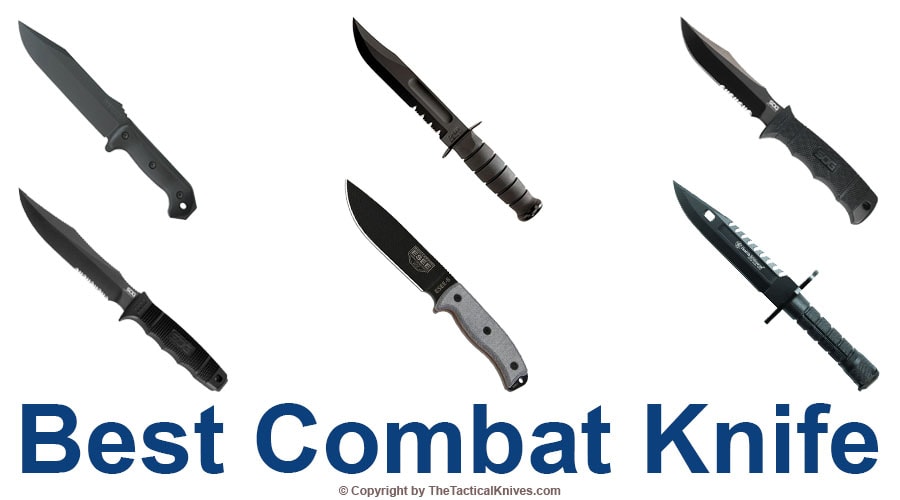
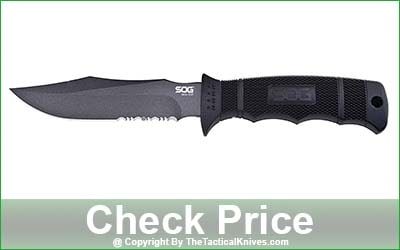
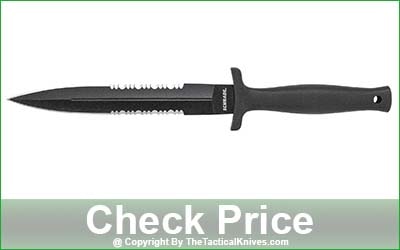
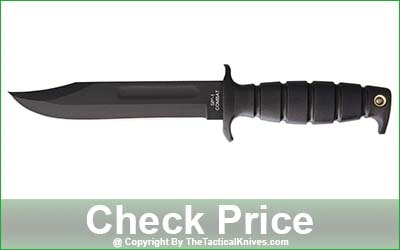
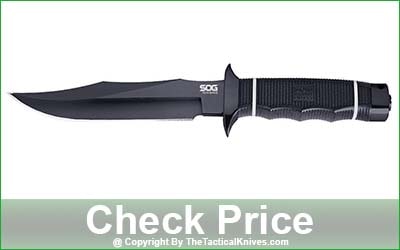
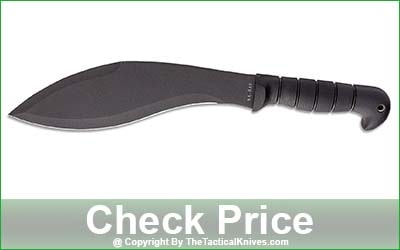
Thanks for sharing such a nice opinion, the post is pleasant, that’s
why I have read it entirely. Keep going on.